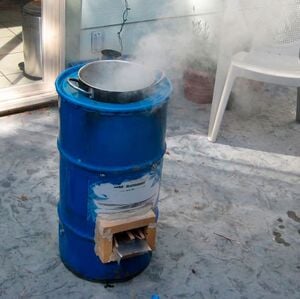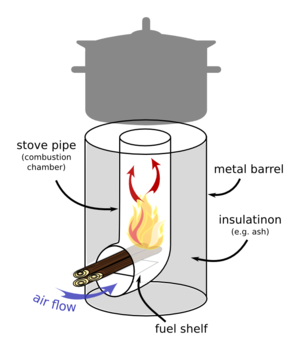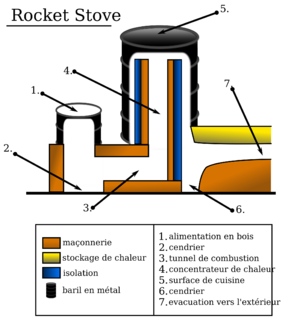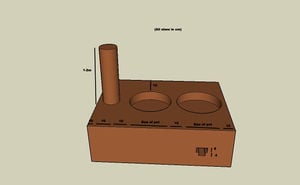Rocket Stove Design Tool Instructions

| Keywords | stove, heat, rocket stove, energy, cooking, efficiency, oven, stoves, Homepage |
|---|---|
| SDG Sustainable Development Goals | SDG07 Affordable and clean energy |
| Authors | User:McArdle Emilio Velis Pedro Kracht |
| Published | 2008 |
| License | CC-BY-SA-4.0 |
| Translations | Français, Español, Kiswahili, 中文, العربية, Русский, more |
| Impact Number of views to this page. Views by admins and bots are not counted. Multiple views during the same session are counted as one. | 21,715 |
| Cite as User:McArdle, Emilio Velis, Pedro Kracht (2008). "Rocket stove". Appropedia. Retrieved 2021-11-27. | |
| Download PDF | |
A rocket stove is a variety of wood-burning cooking stove with a higher efficiency than other types of traditional ovens due to a better insulation and a better combustion process. They function under a similar principle as rocket stove mass heaters. Most rocket stoves are easy to build, and can be made with low-cost materials.
There is a wide variety of designs amongst stoves included in the 'Rocket Stove' family, but they have the following characteristic features:
- The combustion chamber and interior stove parts are as insulative and lightweight as possible. Heavy materials in contact with hot flue gases absorb heat that could have been used for cooking.
- The combustion chamber is insulated in order to keep the fire hot (above 650 ºC) to burn the wood more completely, thereby reducing smoke (which is fuel that has not burnt completely).
- The combustion chamber is usually in the shape of an elbow or letter 'L', so that wood is placed under a short internal chimney as it is fed into the stove.
- Wood is burned at the tips and is pushed in towards the fire as it burns. Feeding fuel at the correct rate creates cleaner combustion, reducing smoke.
Projects on Appropedia [edit | edit source]
Overview [edit | edit source]

Barrel rocket stove for outdoor cooking
A rocket stove addresses air quality problems arising from the use of an open pit fire for cooking and home heating. Biomass fuels release large amounts of air pollutants when burned on traditional open pit fire, and these pollutants become concentrated in inadequately ventilated homes and dwellings, generating respiratory problems to families, especially in rural areas.
Another concern with traditional wood fires is the environmental cost due to inefficiency of fuel consumption. Traditional open pit wood fires are very efficient at turning wood into energy, but inefficient at transferring the released energy into the cooking vessel. Most of the released energy in the wood is wasted heating the surrounding air rather than heating the cooking vessel. The inefficient transfer of energy requires the use of more wood, which has to be harvested from the surrounding environment, causing environmental stress.
The third drawback of traditional wood fires is the danger to children. Because open fires are located on the floor of the dwelling, children can easily fall into the fire.
The rocket stove operates roughly twice as efficiently, and substantially more cleanly, than the open fire cooking methods still used in many areas of the world. Furthermore, the design of the stove requires small diameter lengths of wood, which can generally be satisfied with small branches. As such, sufficient fuel for cooking tasks can be gathered in less time, without the benefit of tools, and ideally without the destruction of forested areas.
Because these qualities improve local air quality, and discourage deforestation, the rocket stove has attracted the attention of a number of appropriate technology concerns, which have deployed it in numerous third-world locales (notably, the Rwandan refugee camps). This attention has resulted in a number of adaptations intended to improve convenience and safety, and thus the size of the target audience. The Justa Stove, for example, is a cousin of the rocket stove adapted for indoor use and family cooking needs.
Construction [edit | edit source]

A rocket stove is a simple mechanism mostly made of the following elements:
- Chimney: this can be made out of a metal box --such as a 5-gallon tin can-- or pipe standing vertically to support the cooking vessel.
- Fuel magazine: a short length of steel or ceramic pipe fitted horizontally into the base of a chimney.
- Fuel shelf: a flat plate to hold the fuel clear of the bottom of the magazine to allow air to flow underneath.
- Heat exchanger: a tubular metal shield that forces hot gases from the chimney to pass over the sides of the cooking vessel.
Some of the principles for building a rocket stove are:[1]
- Insulating every element in contact with the fire and hearth.
- Drive the flow of combustion gasses around the edge of the cooking pot.
- A good air draft into the fire to increase the air flow speed.
- Design the stove so that the pot comes as close to the fire as possible.
- Consider the use of metal pots for cooking.
- Insulation around the fire
Metering the fuel The most important factor, metering the fuel, requires only the burning portion of the wood to be heated. Fully burned biomass fuel produces less smoke and emissions. The main way to improve the fuel efficiency of rocket stoves is to improve the heat transfer from the fire to the cooking vessel.
Most importantly, the hot air and gas released from the fire must contact the cooking vessel over the largest possible surface area. This is accomplished through the use of a pot skirt that creates a narrow channel forcing hot air and gas to flow along the bottom and sides of the cooking vessel. Heat transfer can also be increased by using wide pots. Increasing the speed of the hot gases that flow around the pot can also improve heat transfer.
Rocket Lorena stove [edit | edit source]

The rocket-lorena stove is a 2 pot rest stove and has an efficient conversion chamber which requires very little fuel. It has a firewood chamber and a chimney which further improves efficient burning. It can be made from locally available materials and so is affordable.
It is a great improvement over the normal three stone stove, that is common in villages, because of the vastly reduced fuel consumption, it simplicity to use and the short time it takes to cook food. The chimney mechanism reduces smoke and associated problems and it is firmly attached to the ground meaning there is less risk of injury occuring from spillages or accidents.
Its disadvantages are that it is less portable than the three stone stove and occupies a larger space. The rocket-lorena normally takes a number of hours and several people working to finish. That said once built, it is long lasting and durable (at least 10 years)
The Rocket Box Stove [edit | edit source]
The Appropriate Infrastructure Development Group (AIDG) promotes affordable and environmentally sound access to electricity, sanitation and clean water. Through a combination of business incubation, education, and outreach, AIDG helps people get Access to technology that improves quality of life. Until 2010 AIDG Guatemala carried out technical R& D on the Rocket Box and other products designed for the local market.
AIDG's development of the Rocket Box stove was undertaken to alleviate the problems created by open fire cooking in rural Guatemala. The health, environmental, and economic costs of the traditional open-fire method of cooking have been widely documented. They include respiratory illnesses and accidental burns; the financial burden and time to buy or gather fuel; and de-forestation. AIDG's work to design the Rocket Box has a context in the widespread initiatives by NGOs to promote efficient cook-stoves in Guatemala.
The aim of AIDG's stove programme has been to develop a product for the market that caters for Guatemalan families' traditional cooking habits, and is affordable to them. These are necessary conditions for the Rocket Box to effectively contribute to solving these social problems. The design also seeks to maximise fuel efficiency and allow smoke to be removed from the house.
After several iterations, the result of the project is the Rocket Box stove, a metal-bodied stove which incorporates the Rocket combustion chamber into a portable and attractive 'plancha' stove. A 'plancha' or griddle is usually a feature of Guatemalan cook-stoves allowing the preparation of corn tortillas.
The Rocket Box is a portable wood burning stove. It uses a Rocket combustion chamber for high-efficiency combustion and pumice as insulation to make sure that the heat goes only where it is needed. The combustion chamber is made of baldosa tiles. The body is sheet steel. The plancha is 18" wide by 24" long, and has removable rings to allow direct contact of the flame or hot air with the pots or pans being used for cooking. A large front ring allows food to be bought to a boil and two smaller back rings are for simmering/ keeping food warm. Pumice stone is a natural resource in Guatemala. It has a low density and there are air gaps in the stone itself. This air acts as an insulant meaning the heat operates directly on the plancha.
An important feature of the Rocket Box stove itself is a grate for the wood to sit on inside the combustion chamber. This allows air to flow underneath the fuel. Without it the stove takes longer to heat and uses more fuel.
Unitil 2010 Rocket Box was manufactured and sold by AIDG's local partner, Xelateco.
Literature review [edit | edit source]
Uses and benefits [edit | edit source]
Wood, charcoal, coal and other biomass are used by about 2.4 billion people worldwide as their primary cooking fuel. In 'developing' countries, these fuels are often burned in open fires or poorly functioning stoves.[2] Several factors from these cooking processes have been shown to be damaging to human health, especially attributing to respiratory related illness. Indoor smoke given off by these fuels contains constituents including small soot or dust particles that are able to penetrate deep into the lungs. Every year, indoor air pollution is responsible for the death of 1.6 million people -one death every 20 seconds.[3]
Women and children being the ones most involved or exposed to this environment are worst affected. Charcoal production has been associated with environmental issues such as deforestation which further increases other environmental and social vulnerabilities. The trees that grow most slowly; hardwood trees make the highest quality charcoal, furthering the impact. Wood or wood charcoal is the primary cooking fuel in Haiti, and this dependence has contributed to only 2% of Haiti's forests remaining. In places like Haiti, the limited availability of wood means that finding gathering fuel consumes time and energy, causes more severe weather, increases vulnerability, reducing capacity, costs money and further stresses an already depleted resource. In some places such as in Mali, due to changes in the energy and economic sectors a pronounced shift from fuel wood to charcoal is happening which is raising concerns for the local resources.
The main justifications for rocket stoves are economical, social, and environmental. Stove programs can produce economic benefits, saving time and money for the users. In urban areas where people purchase biomass fuel, the payback time for the cost of a rocket stove is short, thus saving on the cost of fuel.
Rocket stoves can help reduce the over-harvesting of trees. Improved indoor air quality and fuel efficiency have social and health benefits, especially for women and children. In order to reduce indoor air pollution, rocket stoves must improve combustion of the wood fuel, which means reducing the amount of smoke and harmful emissions produced during the burning process. The key to efficient combustion is to burn wood at a high temperature, and there are several ways to achieve this:
Rocket stoves are insulated and lifted off of the floor. This reduces the danger of children burning themselves, which is an important improvement over traditional open pit fires.
International aid [edit | edit source]
- Kenya: Rocket stoves by PSDA with support from GIZ.[4]
- Guatemala: Guatemala Stove Project by Aprovecho Research Center [3]
[edit | edit source]
- The Paradigm Project [4].
- Justa stoves [5].
Video tutorials [edit | edit source]
- How to make a Rocket Box Stove - AIDG
- How does a Rocket Oven Work? - By Paul Wheaton from permies.com
External links [edit | edit source]
- Wikipedia:Rocket stove
- Poster on how to make a Rocket Stove
- Videos, pictures, and diagrams on how to make a rocket stove mass heater
- Clean Cooking Catalog
References [edit | edit source]
- ↑ Still, Dean, and Larry Winiarski. "Increasing fuel efficiency and reducing harmful emissions in traditional cooking stoves." Boiling Point 47 (2001): 36-39. [1]
- ↑ Smith,K.R."Health impacts of household fuelwood use in developing countries" Food and Agriculture Organization of the United Nations
- ↑ World Health Organization. "Indoor air pollution and health"
- ↑ PSDA-GIZ Rocket Stove Manual [2]
Rocket Stove Design Tool Instructions
Source: https://www.appropedia.org/Rocket_stove
Posted by: riveracrourt.blogspot.com

0 Response to "Rocket Stove Design Tool Instructions"
Post a Comment